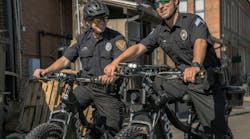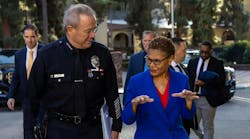On that Thursday afternoon, Bill Cassidy, a communications professor, sat in his office on the first floor of Reavis Hall. What was unfolding as a quiet afternoon of e-mailing and advising on campus would prove to be deceiving; Cassidy's office, located approximately 50 meters away from Cole Hall, was positioned in the eye of a gunman's violent storm.
Seated in the same chair he occupied on Feb. 14, 2008, Cassidy peered out his office window facing Cole Hall and described what he observed that afternoon, which would turn out to be the day of one of the deadliest university shootings in the nation's history.
"We could see police around, you could see them bringing people out in stretchers — I did not see any blood or gore," says Cassidy, assistant professor of communication at Northern Illinois University (NIU), recalls. "We did not have any idea … something really bad had happened."
In the months after the 2007 massacre at Virginia Polytechnic Institute and State University, or Virginia Tech, the two-hour killing spree throughout several buildings that claimed 32 lives and injured many others, law enforcement was able to review the incident and learn from mistakes made in responding.
In contrast, after a former student opened fire at DeKalb, Illinois, the rapid police response, fluid public safety coordination and consistent preplanning serve as an example of how management was able to reduce the toll of harm in the wake of spontaneous violence.
Cooperative system in place
On Feb. 14, 2008, 27-year-old NIU graduate Steve Kazmierczak, armed with three handguns and a shotgun, opened fire on a large geology class. In the end, 21 people were shot and five died in the lecture hall shooting at Cole Hall, situated in the heart of the NIU campus. The gunman ended the violence by turning the gun on himself. The cooperative public safety system in place at NIU, planning and a dose of luck combined to enable police, fire and EMS personnel to swiftly respond, secure the scene and ultimately treat and transport victims in enough time to save lives.
Chiefs Bruce Harrison and Donald Grady of the DeKalb Fire Department and NIU Police Department respectively, cite the relationship between their agencies as a chief player in the successful response to the tragedy, which staff and students refer to as simply 2/14. Both men are quick to point out that the relationship is something they've been cultivating over time and through consistent effort.
"You don't have the kind of relationships that will make a difference if you don't work on them," Grady says. The chiefs say they routinely meet, create joint incident action plans and have been able to build up a level of trust that is rarely seen between fire and police.
"It's not just the police department doing one and then the fire department does their own — we do ours together, combined," Grady says. "We have what we call a 'communiversity' system here where the fire department, the convocation center, the athletic department, the police department, all of those groups get together and we work on building plans and operational relations together all the time."
"We've gone beyond the typical relationship," emphasizes Harrison. He says the trust and rapport in his department's relationship with the NIU Police Department is not a result of the mass shooting, but that it's a cooperative system that's been in place for years, built because the two entities wanted to be a good servant to their communities.
"It's not that we kind of say hello to one another, see each other and then maybe work an event together sometimes. Everything that we do is joint," Grady says.
What made the difference?
In addition to the trust and close working relationship between fire and police, several other elements unique to NIU helped to save lives.
Grady boasts that NIU PD's 62 sworn officers are all trained as emergency medical technicians, some to the paramedic level, through the Kishwaukee Medical System, as are the Fire Department personnel. On 2/14, this cross-trained medically savvy police team was another instrumental element in the response. Harrison says because NIU PD officers were EMT certified through the same training as the fire personnel, he knew that the patients in the building would be cared for until it was cleared for fire personnel.
"Those interventions have been proven to make a difference and have saved lives — I would wish that on everybody," Harrison says. After the shooting was called in, an officer was on the scene in about 30 seconds. The NIU PD long ago adopted the policy that in the event an active shooter is on campus, the first officer on scene would enter the building. So an officer entered Cole Hall within a minute of the reported active shooter.
"Hostage takers do not shoot hostages before negotiating," Grady explains. Grady, who celebrates eight years at NIU this year, has been in civilian police work in the United States in Wisconsin, New Mexico and internationally in Bosnia, Austria, Kosovo and Iraq. He believes that engaging the shooter and having an armed officer enter the scene is the best way to mitigate spontaneous violence.
Each year, a mass casualty drill is held in combination with Homecoming on campus that not only educates students on safety practice and mimics a drunk driving accident, but it also gives an annual dress rehearsal for neighboring agencies to practice response together. Harrison says the drill that took place five months prior to the shooting was eerily similar to the mass casualty incident on 2/14, including the number of patients involved. Officer Terry Williams, with NIU PD for three years and an alumnus, says the chief's progressive philosophy keeps he and the other more than 60 member teams in constant training, requiring 200 hours of training during summer semester, when the campus is least inhabited.
"You play like you practice," Williams says. "If you practice hard — train hard and keep your brain moving, you will be prepared."
Finally, chiefs Harrison and Grady say that without some luck that day, more than five students may have lost their lives. When the Kishwaukee Community Hospital was alerted of the shooting and incoming patients, Harrison remembers that it was during a shift change for hospital staff and thus there were extra medical personnel on hand and waiting to receive victims. The hospital's surgeons were also in a meeting at the time, so a host of doctors were available to operate on the shotgun wounds.
Changes
The campus is not untarnished, however. In addition to the loss of five lives and the lasting effects on survivors, responders and the Huskie community, the effects of the shooting are present, some in surprising ways.
Mehwish Qaim, a specialist in the Office of Emergency Management and Planning at NIU, is also an NIU graduate. She was a resident advisor in a private residence hall and had to clear the halls and monitor the floors during the lockdown following the shooting. She says the experience as a student at a university that suffered a mass shooting inspired her to get into emergency prep and planning.
Though Grady says 2/14 didn't change how the agency does business, NIU PD has since gone seen some changes. "I've been all over the world and I've seen all kinds of things," Grady says. "2/14 is one of those things that you expect could happen in your lifetime, and it did. We recognize that we have to be more diligent and always look for the best way to do policing to assure it doesn't happen again, or mitigate the circumstances as much as possible so that we don't have as much damage as we had in the past."
Some of those new policing efforts include a special secret force of sworn police officers whose entire job it is to protect classrooms. In an effort to deter future acts of violence at the university, NIU has sped up implementation of a previously planned program, called the Community Assault Mitigation Program for University Settings, or CAMPUS. The officers are armed, SWAT trained and outfitted in ballistic protection and attend classes, football games, dances and other campus events as full-time students.
As a result of the shooting, Grady says all campus buildings were also equipped with additional medical kits that include equipment such as EpiPens and oxygen. Both chiefs say having a cache of medical equipment is critical in a mass casualty incident and also helps the campus support itself in the event of a natural disaster or medical emergency.
Lastly, in May the department expanded into another building, which included a high-tech emergency operations center on campus and a secondary center a few miles off campus.
Silver linings
In incidents of spontaneous violence, not much can be done to predict and interdict a gunman prior to shooting. But what can be garnered from the incident at NIU is that a swift response by prepared public safety personnel can make all the difference in saving lives and reducing injury. The police, fire and EMS cooperation can give the community some peace of mind, knowing that though we can't control if a gunman erupts, we can respond to it in a quick and controlled manner that gives citizens a sense of safety, even in the wake of violence.
"I really think if someone wants to do something, you really can't stop them," Cassidy says. "[NIU Police] are specialists that know what they're doing. In terms of dealing with the incident itself and getting here — to the scene — I think the folks here did a really, really good job, so I'm not worried."
For a university not dwelling on the indiscriminate killings, it's business as usual as the spring semester ends its first full school year since 2/14. NIU is able to harvest the silver linings from the storm cloud that erupted in Cole Hall and in the shadow of slaughter, continue its mission as campus police to protect, serve and educate.
Editor's note: Chief Grady asked that we not publicize specific details about the CAMPUS program; the operation's deterring factor is that the undercover officers' identities as well as the number of officers on the force are kept confidential. He welcomes any agency with questions or interested in adopting a similar program to e-mail him at [email protected].



